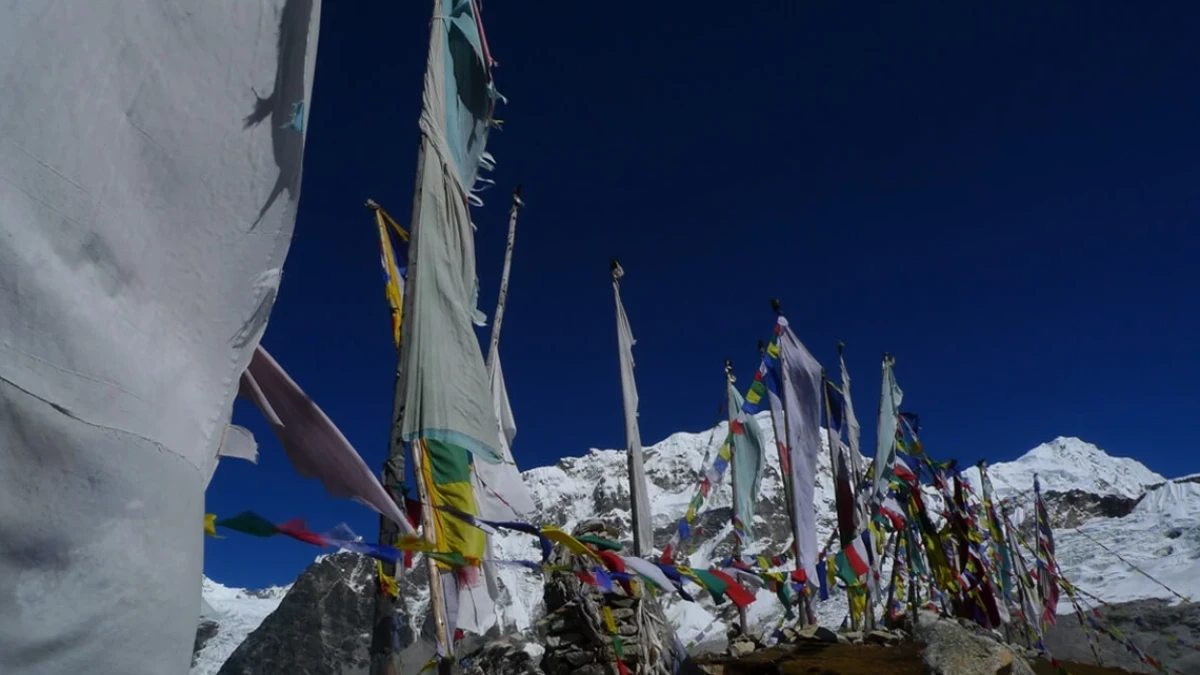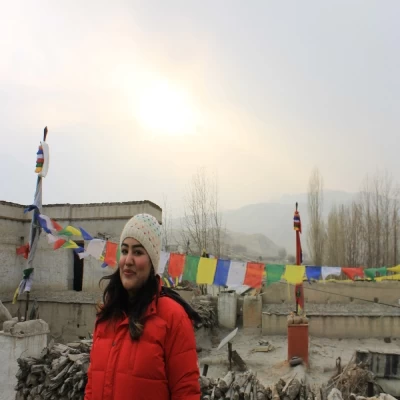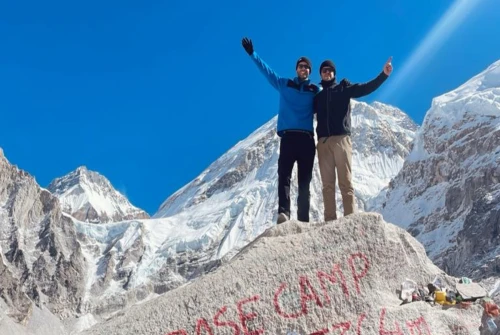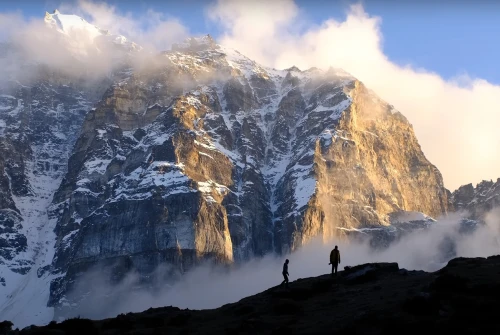Overview
The Annapurna Circuit Trek is one of Nepal’s most iconic and rewarding trekking adventures, offering a breathtaking journey through diverse landscapes, climatic zones, and cultural regions. Stretching between 800 meters and 5,416 meters, this circuit takes trekkers from subtropical valleys and terraced farmlands to alpine meadows and the arid, high-altitude deserts of the Himalayas. Due to this vast elevation range, the weather varies drastically, meaning that every month offers a distinct trekking experience.
Understanding the monthly weather variations is crucial before planning your Annapurna adventure. The right timing determines not just the comfort of your trek but also its safety and success. Each season brings unique rewards: spring’s rhododendron blooms, monsoon’s lush greenery, autumn’s crystal skies, and winter’s serene solitude. Whether you prefer clear mountain vistas or peaceful off-season trekking, knowing what to expect each month helps you make an informed decision.
The Annapurna Circuit is open year-round; however, weather conditions significantly impact trail accessibility, teahouse availability, and the overall atmosphere of the journey. The best time to trek usually falls between March to May (spring) and September to November (autumn) when visibility is superb, temperatures are moderate, and the high mountain passes like Thorong La (5,416m) remain accessible.
In this comprehensive monthly weather guide, we explore everything, from seasonal weather patterns and temperature breakdowns to comparisons with other famous treks and packing tips, so you can confidently plan your unforgettable journey around the Annapurna massif.
Is the Annapurna Circuit Trek Safe?
The Annapurna Circuit Trek is considered one of the safest long-distance treks in Nepal when trekked during the right seasons and with proper preparation. The trail is well-established, marked, and serviced with lodges and teahouses throughout the route. However, safety varies greatly with the season.
During autumn and spring, conditions are stable, visibility is excellent, and mountain passes like Thorong La are snow-free, making it the safest time to trek. In contrast, winter months (December–February) can bring heavy snowfall, icy trails, and freezing temperatures at higher elevations, sometimes leading to temporary trail closures. Similarly, monsoon season (June–August) introduces landslides, slippery paths, and leeches in the lower sections, though upper areas in the rain shadow, like Manang, remain safer and drier.
Altitude sickness remains the primary safety concern as trekkers cross over 5,000 meters. A slow ascent, proper acclimatization days (especially in Manang), and hydration are key preventive measures. Hiring a licensed guide or porter further enhances safety, especially in unpredictable weather.
Overall, with the right timing, preparation, and gear, the Annapurna Circuit is an incredibly safe trek suitable for both seasoned and first-time adventurers.
Seasonal Weather Patterns and Their Impact on the Annapurna Circuit Trek
The Annapurna region experiences four distinct seasons, each influencing the trail conditions, scenery, and overall trekking experience. Understanding these seasonal changes ensures that you choose the period that aligns with your expectations, whether you desire bright floral trails, quiet paths, or panoramic views.
Spring (March–May): The Blooming Season for Annapurna Circuit Trek
Spring is one of the most popular and scenic seasons to trek the Annapurna Circuit. The entire region awakens with color as rhododendrons, magnolias, and orchids bloom across the mid-hills, creating breathtaking contrast with the snow-capped peaks above.
Temperature:
Lower regions (800–2,000m): 15°C–25°C
Mid-hills (2,000–3,500m): 5°C–20°C
High altitudes (above 4,000m): -5°C–10°C
Rainfall: Light to moderate toward late May
Weather: Clear skies, stable conditions, warm days, and cool nights.
March marks the transition from winter to spring. Trails begin to reopen fully, and snow at high passes starts melting. April is often considered the best spring month, the skies are consistently blue, and the views of Annapurna, Dhaulagiri, and Manaslu are extraordinary. By May, temperatures rise, making the trek more comfortable, although haze and afternoon clouds begin appearing.
Spring trekking also coincides with festivals like Nepali New Year (April) and Buddha Jayanti (May), giving trekkers a taste of local culture along the route.
Monsoon (June–August): The Wet and Challenging Season
The monsoon season transforms the Annapurna Circuit into a lush, green paradise but also brings challenges like rainfall, humidity, and leeches in the lower elevations. It’s the least popular season due to frequent showers and limited mountain visibility. However, it still offers a unique charm and opportunities for solitude.
Temperature:
Lower regions: 18°C–26°C
Mid-hills: 10°C–20°C
Higher altitudes: 0°C–12°C
Rainfall: High (250–400 mm monthly average)
Weather: Cloudy, humid, occasional downpours, misty mornings.
Despite the rain, the rain-shadow areas of Manang and Mustang remain relatively dry and are still trek-friendly during this period. The landscape is at its most vibrant, waterfalls are spectacular, and the trails are nearly empty. Late August begins transitioning to autumn, with reduced rainfall and fresh, clear post-monsoon air.
If you don’t mind rain and prefer peaceful, uncrowded trekking, the monsoon can be a rewarding and unique time to experience the Himalayas’ raw beauty.
Autumn (September–November): The Prime Trekking Season
Autumn is undoubtedly the best and most popular season for the Annapurna Circuit Trek. The monsoon rains have washed the skies clean, leaving behind crystal-clear mountain vistas, fresh air, and vibrant landscapes. Trails are alive with trekkers from around the world, and local teahouses brim with festive energy.
Temperature:
Lower regions: 12°C–22°C
Mid-hills: 5°C–15°C
Higher altitudes: -5°C–10°C
Rainfall: Minimal, very dry and stable conditions.
Weather: Sunny, clear, and ideal for long trekking days.
September begins with post-monsoon freshness, while October and November are the golden months for the Annapurna Circuit. Days are warm, nights are crisp, and the skies remain consistently blue. The majestic views of Annapurna I, Gangapurna, and Tilicho Peak appear unobstructed. The high pass of Thorong La remains safely accessible, and the pleasant weather allows trekkers to fully enjoy the journey.
Autumn also coincides with Nepal’s biggest festivals, Dashain and Tihar, adding cultural vibrancy to your trekking experience.
Winter (December–February): The Cold and Serene Season
Winter on the Annapurna Circuit offers a different kind of beauty, peaceful trails, crisp air, and snow-covered peaks that gleam under clear blue skies. While daytime trekking at lower altitudes remains enjoyable, the higher sections, especially near Thorong La Pass, can experience heavy snow and extreme cold.
Temperature:
Lower regions: 5°C–15°C
Mid-hills: -2°C–10°C
High altitudes: -10°C to -25°C
Rainfall: Very low; mostly dry with occasional snow.
Weather: Clear skies, cold winds, and limited trail accessibility at higher points.
December is still suitable for trekking if you stay below 4,000 meters, but January and February bring harsher cold. The trail is much quieter, teahouse availability decreases, and icy sections can make crossings challenging. However, for those seeking solitude, clear photography conditions, and a real sense of wilderness, winter trekking can be deeply rewarding.
Summary: Choosing the Right Time to Trek
Choosing the right time for the Annapurna Circuit Trek depends on your preferences for weather, scenery, and crowd levels.
- For the best overall experience, trek in autumn (September–November) for clear skies, ideal temperatures, and stable conditions.
- For colorful scenery and mild warmth, spring (March–May) is a close second, with blooming flowers and vibrant forests.
- If solitude and snow appeal to you, consider winter (December–February)—just ensure you’re well-prepared for freezing temperatures.
- Adventurers seeking quiet and greenery can brave the monsoon (June–August) in the drier regions of Manang or Mustang.
Each season showcases a unique side of the Annapurna region, but all demand good preparation, flexibility, and respect for nature’s unpredictability.
Annapurna Circuit Trek Temperature Overview
Because the Annapurna Circuit spans various altitudes, temperatures fluctuate dramatically between regions. Lower valleys (like Besisahar) remain warm year-round, while high passes (like Thorong La) can drop far below freezing even in spring or autumn.
Month | Lower Region (800–2,000m) | Mid Region (2,000–3,500m) | High Region (3,500m–5,400m) |
January | 5°C – 15°C | -5°C – 10°C | -10°C – -20°C |
February | 7°C – 17°C | -3°C – 12°C | -8°C – -15°C |
March | 10°C – 20°C | 0°C – 15°C | -5°C – 10°C |
April | 12°C – 23°C | 3°C – 18°C | -2°C – 12°C |
May | 15°C – 25°C | 5°C – 20°C | 0°C – 13°C |
June | 18°C – 26°C | 10°C – 22°C | 2°C – 12°C |
July | 19°C – 27°C | 12°C – 23°C | 4°C – 13°C |
August | 18°C – 25°C | 10°C – 21°C | 2°C – 10°C |
September | 16°C – 23°C | 8°C – 18°C | -2°C – 8°C |
October | 12°C – 20°C | 5°C – 15°C | -5°C – 5°C |
November | 8°C – 17°C | 2°C – 12°C | -8°C – -3°C |
December | 6°C – 15°C | -3°C – 8°C | -12°C – -18°C |
Annapurna Circuit Trek vs Annapurna Base Camp vs Everest Base Camp Trek
1. Scenery and Landscape
The Annapurna Circuit is famous for its diversity, from subtropical forests to the arid deserts of Manang and Mustang. The Annapurna Base Camp (ABC) trek stays within lush valleys and alpine meadows, offering a close-up view of the Annapurna Sanctuary. Meanwhile, the Everest Base Camp trek features glacial landscapes, Sherpa villages, and dramatic views of Everest, Lhotse, and Ama Dablam.
2. Difficulty Level
The Annapurna Circuit is longer and involves crossing the high Thorong La Pass (5,416m), making it moderately challenging but manageable with proper acclimatization. ABC is shorter and less demanding, ideal for beginners. EBC is physically tough due to altitude and terrain but well-supported.
3. Weather and Best Time to Trek
All three treks share similar weather patterns. Autumn (Sept–Nov) and Spring (Mar–May) are ideal for each other, but Annapurna Circuit’s rain-shadow areas allow limited trekking even in the monsoon. EBC tends to be colder due to its higher elevation.
4. Crowd Level
EBC is the most crowded during peak seasons, followed by the Annapurna Circuit. ABC and the Manaslu Circuit offer more peace, especially outside of October.
5. Cost Comparison
On average:
Annapurna Circuit: USD 1,200–1,800 (15–20 days)
Annapurna Base Camp: USD 800–1,200 (7–10 days)
Everest Base Camp: USD 1,500–2,000 (12–14 days)
Annapurna Circuit remains cost-effective, thanks to its flexible itineraries and accommodation variety.
Annapurna Circuit Trek Monthly Rainfall Guide
For trekkers curious about similar weather in neighboring regions, the Manaslu Circuit has distinct rainfall patterns. The monsoon affects lower valleys like Soti Khola heavily, while Lho and Samagaon remain comparatively dry due to rain shadows.
Month | Average Rainfall (mm) | Weather Description |
January | 25 mm | Cold, dry, clear skies |
March | 50 mm | Mild, blooming season |
June | 350 mm | Peak monsoon, wet trails |
August | 400 mm | Frequent rain, green landscapes |
October | 40 mm | Dry, clear, perfect trekking |
December | 15 mm | Dry and cold, fewer trekkers |
Comprehensive Packing Guide for Annapurna Circuit Trek
Packing correctly can make or break your Annapurna Circuit experience. Given the altitude range, you’ll need to layer for both warm valleys and freezing mountain passes.
Essential Clothing:
- Base layers (thermal tops & bottoms)
- Fleece or softshell jacket
- Insulated down jacket
- Waterproof & windproof outer shell
- Trekking pants & quick-dry shirts
- Warm hat, gloves, buff/scarf
Footwear & Gear:
- Waterproof trekking boots with ankle support
- Gaiters for snow or mud
- Trekking poles
- Sunglasses & sunscreen
- Sleeping bag (comfort rating -15°C)
- Reusable water bottle & purification tablets
Miscellaneous:
- Headlamp with extra batteries
- First aid kit & altitude medication
- Snacks & energy bars
- Quick-dry towel
- Portable charger or solar power bank
Packing light yet efficiently ensures comfort and safety across changing climates.
FAQs About Annapurna Circuit Trek Monthly Weather
1. What is the best month to trek the Annapurna Circuit?
October is widely regarded as the best month due to stable weather, crystal-clear views, and pleasant temperatures.
2. Can I trek the Annapurna Circuit in winter?
Yes, but you must be prepared for freezing conditions and possible snow closures. Stick to lower sections and carry winter trekking gear.
3. Is the monsoon season safe for trekking?
It’s safe if you trek in rain-shadow regions like Manang or Mustang. However, leeches and slippery trails are common in lower areas.
4. How cold does it get at Thorong La Pass?
During winter, temperatures at Thorong La (5,416m) can drop to -25°C at night. Even in autumn, it can reach -10°C.
5. Which season has the clearest mountain views?
Autumn (October–November) offers the clearest skies and best visibility across the Himalayas.
6. What should I pack for the Annapurna Circuit Trek?
Layered clothing for varying temperatures, waterproof gear, and quality boots are essential. Don’t forget sun protection and a sleeping bag rated for sub-zero nights.
7. Are there risks of altitude sickness?
Yes. Gradual ascent and acclimatization—especially in Manang (3,500m), are vital to prevent altitude sickness.
8. Can beginners do the Annapurna Circuit Trek?
Yes. With moderate fitness, proper guidance, and gradual pacing, beginners can complete the trek.
Conclusion
The Annapurna Circuit Trek offers an extraordinary adventure through Nepal’s diverse landscapes and weather patterns. From the vibrant blooms of spring to the golden calm of autumn, every season paints a different story on the trails. Understanding the monthly weather and seasonal nuances ensures you experience this Himalayan masterpiece at its very best.


.webp)

